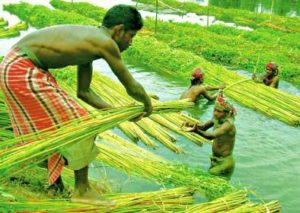
Say ‘No’ to Wood Charcoal, Try Charcoal from Jute Stick
In Africa charcoal or activated carbon is a source of income and power. The production of charcoal is responsible for deforestation because everyone knows about its benefits. And day by day it has been started in different countries for the demand for activated carbon. We are not saying stop the use of charcoal but change the ingredient of making this product, or the earth will destroy soon.
You may don’t know how the charcoal is made. Here we are giving you a little brief about how to make the wood charcoal.
How is wood charcoal made?
For wood charcoal, you will need hardwood. Mostly big trees like walnut or the oak tree are preferred because it will give you solid charcoal. After selecting the wood, you will need saw to cut the wood and metal barrel. After that start to burn and you will get your expected, activated carbon.
What is happening with the environment for producing charcoal?
- You may know that the forest is like the lungs of the earth. While our lungs produce carbon dioxide, forest produces oxygen by converting carbon dioxide. Most people cut down trees from tropical rain forests and when those trees are removed from there the humidity drops in that region. Not only the area is hampered, but it also affects thousands of miles away.
- Deforestation adds erosion in the environment. Usually, it happens when soil or rock faded away by wind or water (rain/flood).
- Some animal and trees live in a particular forest. When people destroy their habitat, it seems hard for them to survive and some often die and drive them to extinction.
- Deforestation is changing our climate.
- In controlling global warming, trees play a vital role. Deforestation leads to increasing greenhouse gases in the atmosphere.
- With the help of the roots, trees consume a large amount of water when it rains. But after cutting them down nothing is there for absorbing that water and flood occurs.
What is Jute?
You may know Jute is a type C plant though it isn’t a hardwood but also a member of the wood kingdom. Jute’s genus is Corchorus, and the order is Tiliaceae. There are two species of Jute for commercially cultivating. One of them is C. Capitularies, and another one is C. Olitorious.

Everybody knows Jute is the golden fiber of Bangladesh. Climate, soil and a vast amount of water in Bangladesh increase the growth of Jute. You will need only 120 days to harvest Jute. For cultivating Jute farmers of this country is very expert. In Bangladesh and India, 80% of jute is grown.
Jute Stick charcoal- Alternative of Wood charcoal
For the several advantages of charcoal, wood charcoal production is increasing. But people haven’t even thought once what are they doing with the ecosystem. On the other hand, producing charcoal from Jute stick is a green technology and eco-friendly. Though Jute belongs to softwood, it provides excellent quality activated carbon. The quantity of Jute charcoal is less than the wood one.

Now every year 30 lakh tons of jute sticks produce in Bangladesh. Bangladesh is capable of producing 5, 25,000 tons of charcoal per year. Not only people will get a lot of energy but also can earn money. So, we can cover our demand for charcoal by this Jute charcoal. It can be medically used through oral ingestion, tablets or capsules.
Final Verdict
Jute charcoal can be an alternative of wood charcoal. It will give energy and economic support to the people. Eco-friendly Jute charcoal can save our lungs (forest) of the earth. The reason for writing this article is spreading information that Jute can be a better option for producing activated carbon. Please try not to use wood charcoal, use Jute charcoal and save our world, stay green. Without green, the earth won’t survive long.
Charcoal Desk/Adittya